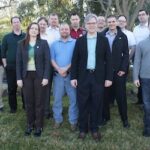|
|
This Presentation date is January 26, 2012 at 08:00-10:00.
Presenters: Abby Strong, Changming Liu, Devin Akin, Matthew Gast
Aerohive at WFD2 Part 1: Devin Akin, Matthew Gast, Founders
Watch on YouTube
Watch on Vimeo
Devin Akin introduces the company and panel content, then Matthew Gast walks through his vision for Wi-Fi. Next up is Aerohive founder and CTO, Changming Liu. Finally, Abby Hassel Strong presents a review of Aerohive’s progress in 2011 and gives a special gift to Chris Lyttle.
At Wireless Field Day 2, Aerohive showcases their latest innovations by highlighting the evolution of wireless technology and their unique architectural approach. Their presentation covers the company’s direction, developments from the past year, and insight into the future of gigabit wireless networks, especially in relation to 802.11ac. Key executives, including Devin Akin, Matthew Gast, and company founder Chia-Ming Liu, discuss the technical progress and strategic vision driving Aerohive’s distributed controller-less architecture forward.
During the presentation, Matthew Gast delves into both the technical progression of the wireless industry and challenges that new standards bring. He cleverly compares traditional wireless controllers to dinosaurs—relics of the past—as 802.11ac and beamforming technologies reshape the landscape. Gast explains critical limitations in existing security protocols such as CCMP and suggests GCMP as a necessary evolution due to higher data rates and the need for parallel encryption. He emphasizes the importance of having up-to-date hardware capable of meeting the advancing specifications. Additionally, he discusses the complexities of 256 QAM modulation, the need for clean radio design, and improvements in performance through features like multi-user beamforming.
Founder Chia-Ming Liu reflects on the vision behind Aerohive’s architecture, conceived to handle gigabit Wi-Fi well before 802.11ac formally arrived. Inspired by a 2005 IEEE demo of fast wireless speeds, Liu deliberately steered away from centralized controller-based designs, opting instead for a distributed model similar to Ethernet’s evolution. Acknowledging the technical challenges posed by distributed architecture, particularly with roaming and RF management, he credits his engineering team for overcoming these hurdles. Wrapping up the session, Aerohive discusses their 2011 product launches, such as the BR100 branch router, Cloud VPN gateway, new access points, and enhanced management software, along with support for features like rogue mitigation, spectrum analysis via iPad, and student management integrations.
Personnel: Devin Akin, Matthew Gast
Aerohive demos at Wireless Field Day 2
Watch on YouTube
Watch on Vimeo
Aerohive’s Paul Levasseur demonstrates Secure Guest Access, Branch on Demand, and “Value on Demand”, configuring the BR100 branch routers on the fly.
During the Wireless Field Day 2 presentation, Paul Levasseur detailed several of Aerohive’s innovative features, beginning with Secure Guest Access. This approach aimed to improve security and reduce reliance on open networks by allowing guests to self-register through a captive web portal and receive private pre-shared keys (PSKs). The network could dynamically assign access credentials based on guest information, with policies further set up according to user profiles and device types. Aerohive also showcased a network-based mobile device management (MDM) approach where policies are applied at the access point level, leveraging user agents and domain logins to control network behavior based on device type or user identity.
Levasseur next demonstrated the Branch on Demand solution, using BR100 routers that can be rapidly deployed across branch sites. These devices come pre-registered with Aerohive’s redirector service, enabling them to auto-configure and find the correct HiveManager regardless of location. Aerohive’s routers support LTE connections for primary or backup access and can switch autonomously in the event of a WAN failure. These routers also act as firewalls, NAT devices, DHCP servers, and local RADIUS servers, integrating easily with external web security solutions like WebSense and Barracuda. The system allows centralized policy creation, including SLAs, user-based whitelisting, and dynamic route provisioning without requiring traditional routing protocol overhead.
Aerohive’s demo culminated in a live, from-scratch setup of a fully functioning corporate router and wireless environment on 14 sites using an iPad. Within 15 minutes, Levasseur configured IPsec VPNs, dynamic routing (OSPF), multi-level user access, web filtering integration, and more. Audience members participated in hands-on tests using private PSKs and self-registration portals. The GUI-driven HiveManager Pro interface allowed seamless management across wireless and wired ports. Emphasizing simplicity and scale, Aerohive presented a compelling case for its distributed, controllerless architecture as a robust and efficient alternative to traditional wireless solutions.
Personnel: Paul Levasseur









